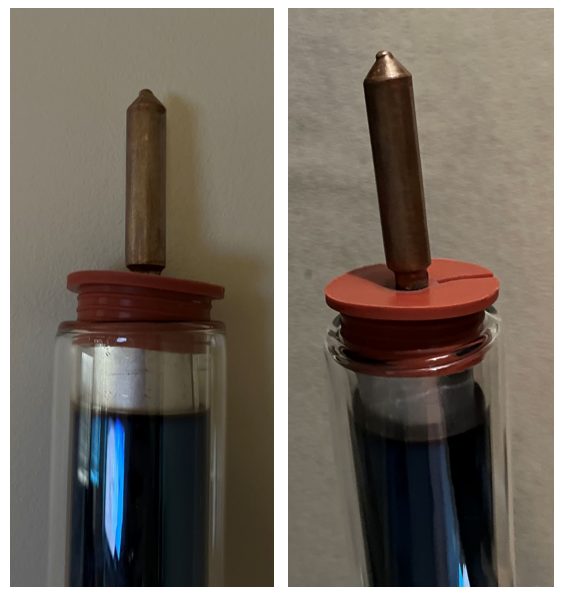Project Category: Multidisciplinary

Project Description and Demonstration
Working with S.P.A. Aqua Prima, we have been tasked with designing a solar thermal outdoor or indoor furniture heating system using solar thermal vacuum tube technology. Our group performed an intensive heat transfer and thermodynamic analysis in order to come up with a system design that would be acceptable by our sponsor. Upon completion of our initial design, the solar vacuum tubes were deemed the core technology since it is the primary means of energy influx to our system.
The type of vacuum tube used in our project is called an evacuated tube heat pipe solar collector, seen below in figure 1 and 2. Its primary function is to collect incident solar radiation, absorb as much energy in the form of heat as possible and transmit this energy to the heat pipe situated within the collector. Inside the heat pipe is a heat transfer fluid such as water or alcohol. In our project, we received our collector from Off-Grid Heating Inc, a local solar thermal supplier and installer. It is made up of typical components found in industry, including two concentric tubes with a vacuum in between that are sealed at the end. The inner tube is coated with a selective coating material allowing for high absorption of solar radiation. Following the inner tube sites a circular aluminum fin that was assumed to be in direct contact to the inner tube which is connected to the heat pipe at the center of the collector. We assumed isopropyl alcohol as the heat transfer fluid inside the heat pipe due to its lower boiling point and freezing point in order to be compatible with weather fluctuations in Calgary, Alberta. However, water is a common fluid often used in industry for different geographic areas. The drawing in Figure 3 shows a breakdown of the components noted above. Figure 1 and 2 below is the vacuum tube used in our heat transfer demonstration video.



Heat Transfer Demonstration Video
See our project in person at the 2022 Capstone Design Fair on April 5th, 2022 in the ENG Atrium.
Meet our team members

The members of this group are in their final semester of the Bachelor of Science Degree (BSc.) in Energy Engineering through the Schulich School of Engineering.
Details about our design
HOW OUR DESIGN ADDRESSES PRACTICAL ISSUES
Canada’s cold climate yields high energy demand for warmth and comfort within its society, year-round. We typically rely on fossil fuels to supply us with energy in the form of heat to keep us comfortable and warm through colder seasons. Energy is viewed as a right in Canada, not as a privilege. The primary objective of this capstone project is to design a solar thermal heating system in a safe, cost effective and efficient manner while aiming for an aesthetically pleasing structure.
WHAT MAKES OUR DESIGN INNOVATIVE
The innovation of our design comes from the incorporation of solar vacuum tube technology coupled with a phase-chase material for thermal storage. This proposed design uses highly efficient vacuum tubes to capture solar thermal energy which is then circulated to a phase change material. The phase change material abuses the melting latent phase range (B-C, shown in figure 4) to store thermal energy for a relatively long period of time after solar energy is no longer available.
The phase change material also ensures safe temperatures are never exceeded. In summary, two relatively new technologies are paired to efficiently capture and store thermal energy. In addition, this method of solar thermal heating provides sustainable solutions to outdoor or indoor heating that could be further investigated.

WHAT MAKES OUR DESIGN SOLUTION EFFECTIVE
It is important to ensure the project design is functional in conditions where utilization of the captured solar heat is dissipated effectively. The system will provide heating to a surface (bench, etc.) that is comfortable in its current ambient conditions. The drawing below shows the initial design of our system.

HOW WE VALIDATED OUR DESIGN SOLUTION
Validation of our design was completed through thorough heat transfer analysis and energy balance calculations using knowledge gained through existing literature and previous University of Calgary courses. Once completed, calculations were verified by our Academic Advisor, Dr. Aggrey Mwesigye as well as our Course Instructor, Dr. Arief Budiman.
FEASIBILITY OF OUR DESIGN SOLUTION
To determine the feasibility of our design solution, the system performance trend in figure 6 shows the approach used for determining the total number of vacuum tubes required to meet the load throughout the year.
Using a control volume around the entire system, we trended the raw insolation data coming in as our Qin, and then our calculated Qout and load demand. The graph below shows a monthly performance trend with 7 vacuum tubes. In the months where Qout is greater than the load, the PCM is being charged during the day whereas the months where Qout is less than the load, additional tubes or auxiliary heating would be required to meet the load.

Partners and Mentors
We want to thank the many people who helped us with this project. Our sponsor, Trina Listanco for the opportunity for our group to become involved with this innovative project that involves regenerative technology and thinks outside the box. Our capstone professor, Dr. Arief Budiman who guided us through the process with patience and great advice. Our Academic Advisor, Dr. Aggrey Mwesigye provided invaluable information and guidance regarding calculations and modeling of the overall system. Finally, our capstone Teaching Assistant Meghdad Ghias, for providing helpful comments along the way.
References
Splung.com Physics. (2022). Latent Heat. (Splung) Retrieved 03 29, 2022, from http://www.splung.com/content/sid/6/page/latentheat
